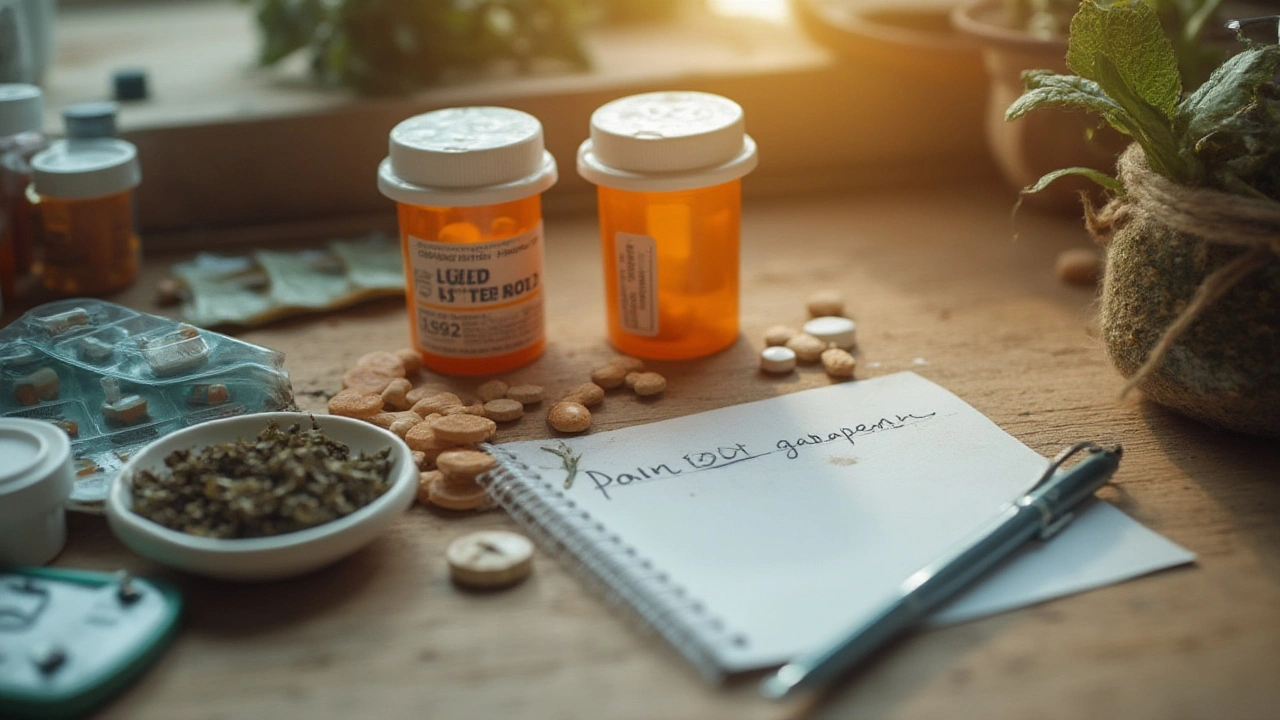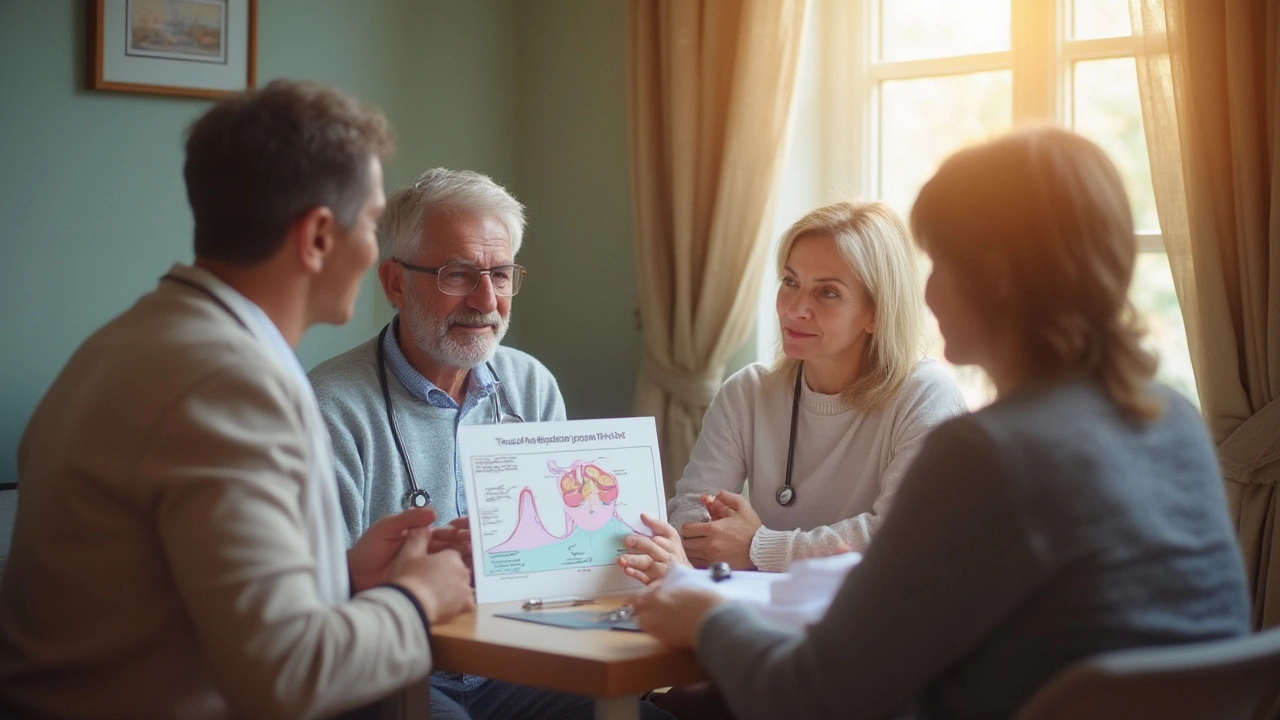Picture this: You’ve been juggling pain for months, maybe years. Every med you try seems like a double-edged sword—kill the pain, but kill your energy, clarity, or mood right along with it. The idea of taking more and more pills, ramping up doses, makes you uneasy. You’re not alone. This is exactly why so many doctors are now eyeing a middle path—combining low-dose gabapentin with other therapies, crafting a personalized formula that blunts pain while keeping nasty side effects at bay.
Why Low-Dose Gabapentin Gets the Nod
Gabapentin’s story is a bit of a love-hate drama in the pain community. When it first took a bow in the 1990s, it was hailed as a game changer for nerve pain—post-shingles, diabetic neuropathy, fibromyalgia, and more. Doctors loved how it soothed that burning, stabbing, strange "pins-and-needles" pain typical in nerve injuries. But as time ticked on, gabapentin’s “perfect drug” sheen wore a little thin. High doses meant risks: brain fog, dizziness, swelling, and for some, a gnawing addiction concern.
Enter the idea of using gabapentin as part of a team, not the star quarterback. When used at low doses—say 100–300 mg a couple times daily—the side effects drop dramatically. Some studies, like one from the Journal of Pain Research in 2023, even suggest many patients feel just as much relief at smaller doses, especially when paired with something else. Still, doctors tweak the dose for each patient. After all, nobody’s pain is exactly like anybody else’s, and those unique body chemistries matter.
So, why the fuss over keeping the dose down? It’s all about lowering risks of memory trouble, balance issues, and the sometimes weird feeling of being "not quite yourself". Hospitals now prize gabapentin for quick, targeted pain relief in surgical patients too, since a single small dose won’t knock them sideways the next day. Add in the fact that gabapentin isn’t a controlled substance in most places, and you see why doctors prefer starting low and slow.

The Art of Layering: How Combination Therapy Really Works
When doctors talk about "layering therapy," they’re really riffing on the same logic chefs use while building a dish. You want just enough of each ingredient, not too much, so every flavor lands without overpowering the plate—or your system. In pain management, that means using different meds, each at a fraction of its maximum dose.
For example, instead of pushing gabapentin to the typical 1,800 mg daily, a doc may stick with 300 mg twice a day. Then, they might add:
- An NSAID (like ibuprofen or naproxen) to tackle swelling and deep ache.
- A small dose of a tricyclic antidepressant like amitriptyline (10-25 mg at bedtime), which dials down pain signals and often helps sleep.
- A topical treatment—lidocaine patches, capsaicin, or even CBD creams—right where it hurts for an extra punch with almost zero side effects.
This kind of mix-and-match lets patients skip the "wallop" from any one med. For neuropathic pain, especially, layering works wonders. In fact, a 2022 review from Pain Medicine found that two-thirds of nerve pain sufferers noticed more reliable relief with a gabapentin combo than with the max dose alone. Even better? They stuck with it. Less dropout equals more stable pain control long term.
Let’s not forget: these combos often mean lower risks for falls, sedation, or accidental overdose, too. Lowered doses reduce those scary long-term risks—like vitamin deficiencies, gut bleeding, or dependence—that keep folks up at night. Docs love being able to fine-tune—if swelling goes up, they can lean on the NSAID a bit more. If nerve pain acts up, a nudge in gabapentin or antidepressant dose might do the trick, without sky-high side effects.
This philosophy also works around the problem of diminishing returns. Over time, one medication alone rarely does the trick. Bodies adapt. Pain finds loopholes. When you hit pain with a balanced team attack, you’re less likely to need constant changes or dangerous escalations.
Not everyone fits the same mold. Some pain responds best with a gentle low-dose opioid layer, or a muscle relaxant—think of older folks with both spinal arthritis and nerve irritation. Others, especially with mood or sleep challenges, get even more benefit when their doctor adds mindfulness-based therapies or gentle stretching regimens, bringing down pain intensity without upping any chemical load.

Tips, Caveats, and When to Explore Alternatives
So, what should you ask your doctor if you’re thinking about a mixed-strategy approach? First, be honest about what’s helped (and what’s hurt) in the past. Docs often want to see how you deal with low-dose gabapentin before stacking other meds, but also appreciate when you track side effects in a pain diary. Don’t shy away from reporting even mild fogginess or dizziness—little changes can usually be adapted with a dose tweak or a different layering choice.
Here’s a concrete trick: Use a simple 1–10 scale daily to score both pain and quality of life. Was your brain clear? Could you do what mattered that day? Sharing these quick notes with your provider makes it easier to spot which med combos are totally worth it, and which aren’t worth the fuss.
Stay sharp about your total med list. Interactions happen, even at low doses. If you take sleep meds, anti-epileptics, or blood pressure pills, flag that early to avoid surprises. And always let someone know if your pain suddenly spikes—unexpected peaks might mean an underlying issue, not just a med miss.
Layering is about more than just popping pills, though. Many doctors are pairing low-dose meds with physical therapy, acupuncture, targeted nerve blocks, or even mental health support. For example, a small 2024 study in the Clinical Journal of Pain showed that pairing low-dose gabapentin with regular yoga cut pain flare-ups in half for women with fibromyalgia. If meditation sounds too mystical, even brisk walks or swimming can support your body’s own ability to tamp pain down—without upping your meds one notch.
If you’re someone who’s tried low-dose gabapentin and gotten nowhere, don’t lose hope. Not every nerve pain fits in gabapentin’s sweet spot, and some bodies can’t tolerate even the smallest dose. Curious about other routes? You’ll find lots of smart, doctor-backed options in this guide to gabapentin alternatives—from other nerve medications to herbal and non-drug treatments that pack a punch.
Some folks even find relief by stacking non-medication tools: E-stim therapy, TENS devices, or cold-laser gadgets, all overseen by a careful clinician. Healthcare teams now meet regularly to brainstorm on the best layers for especially tough cases—no more stuck-in-a-rut routines of one big drug and few other options.
The big takeaway? Combining low-dose gabapentin with other therapies isn’t just about lowering numbers on your pill bottle. It’s about empowerment. You get more control—over pain, side effects, and the ability to enjoy your day. More and more pain clinics are designing flexible plans so that you—yep, the real world you—can get back to life, hobbies, and fun, with pain riding quietly in the backseat, not bossing you around.

Tiffany Fox
July 23, 2025 AT 16:59Low-dose gabapentin changed my life. No more brain fog, just quiet pain and actual sleep. Tried the max dose once-felt like a zombie. Stick to 300mg twice, add a topical, and boom. Life returns.
Keith Avery
July 25, 2025 AT 12:10Oh please. Gabapentin is just a placebo with extra steps. The entire "layering" thing is just pharmaceutical theater. If you actually had real nerve pain, you'd know nothing works except opioids-and even then, it's a crapshoot. This "low-dose" nonsense is what happens when doctors are too scared to prescribe real medicine.
Luke Webster
July 25, 2025 AT 15:50I get where Keith’s coming from, but I’ve seen too many people get crushed by high-dose meds to ignore the data. My dad was on 1800mg gabapentin for years-ended up falling three times. Switched to 300mg + amitriptyline + capsaicin cream? He’s gardening again. No euphoria, no fog, just relief. Sometimes the quiet wins.
Natalie Sofer
July 27, 2025 AT 05:55im not a doctor but i tried this combo after my fibro flare last year and wow. gabapentin 200mg twice + ibuprofen in the day + magnesium at night. my pain went from 8/10 to 3/10. also started walking 20 mins a day. not magic, but it helped. also i spelled everything wrong sorry 😅
Rohini Paul
July 28, 2025 AT 16:25Y’all are overcomplicating this. I live in India, pain meds are expensive as hell. I use turmeric paste, cold showers, and 100mg gabapentin at night. Works fine. Don’t need 5 different pills. Sometimes simple beats fancy.
Courtney Mintenko
July 30, 2025 AT 15:09So you’re telling me the solution to chronic pain is… more pills? How poetic. We’re just swapping one addiction for another while calling it "layered therapy". The real tragedy? You’re all proud of this. You call it empowerment. I call it surrender dressed in a white coat
Sean Goss
July 31, 2025 AT 04:04Let’s not conflate pharmacokinetic modulation with clinical efficacy. The 2023 JPR study had a small n and significant heterogeneity in neuropathic pain phenotypes. Moreover, gabapentin’s NMDA receptor affinity is suboptimal at low doses-this is essentially a placebo-controlled trial with confounding variables. The so-called "layering" paradigm lacks robust RCT validation.
Khamaile Shakeer
August 1, 2025 AT 08:28Bro… this is why I hate western medicine 😅. You take 3 pills, a cream, a patch, yoga, TENS, meditation, and still feel like a robot. In my village, we just drink ginger tea, rub mustard oil, and pray. Pain goes away… or you learn to live with it. Either way, cheaper 😌
Suryakant Godale
August 1, 2025 AT 15:53While the concept of multimodal analgesia is well-supported in the literature, the practical implementation of low-dose gabapentin requires rigorous patient stratification based on genetic polymorphisms of the α2δ subunit. Without pharmacogenomic screening, the efficacy of this approach remains statistically ambiguous and clinically inconsistent.
John Kang
August 2, 2025 AT 22:06You got this. Small steps. No shame in trying a combo. If one thing doesn’t click, try another. Pain ain’t a race. You’re not failing-you’re figuring it out.
Bob Stewart
August 3, 2025 AT 16:25While the referenced 2022 review in Pain Medicine reports a 66% efficacy rate for combination therapy, the definition of "reliable relief" was not operationally standardized across cohorts. Furthermore, adherence rates were self-reported, introducing significant recall bias. Methodological rigor remains a concern.
Simran Mishra
August 4, 2025 AT 21:53I’ve been on gabapentin for 7 years. Started at 100mg. Then 300. Then 600. Then 900. Then 1200. Then 1800. I lost my job because I couldn’t focus. I cried every night because I didn’t recognize myself. My husband left. My cat stopped sleeping on my lap. I tried everything they said: yoga, CBD, acupuncture, TENS, meditation. Nothing worked. Now I’m on 100mg again. And I’m alive. But I don’t feel like I’m living. I just feel… less dead. Is that enough? I don’t know anymore. I just want to stop thinking about it.
ka modesto
August 6, 2025 AT 11:20My physical therapist taught me this trick: if you’re gonna use gabapentin, pair it with movement. Even if it’s just rocking in a chair. Movement tells your nervous system you’re safe. Low dose + gentle motion = magic combo. Try it.
Holly Lowe
August 8, 2025 AT 03:19Low-dose gabapentin is like adding a pinch of cinnamon to bitter coffee-doesn’t kill the bitterness, but makes it worth sipping. Add a little yoga, a little heat, a little quiet, and suddenly you’re not drowning. You’re breathing.
Cindy Burgess
August 8, 2025 AT 07:54The cited studies are largely industry-sponsored. The JPR 2023 paper was funded by Pfizer. The Pain Medicine 2022 review included five studies with financial conflicts of interest. This is not medicine. It’s marketing.
Tressie Mitchell
August 9, 2025 AT 15:44How quaint. You treat pain like a Pinterest board. Layer this. Mix that. Add a sprinkle of mindfulness. Meanwhile, real patients are lying on floors, sobbing, because their insurance won’t cover the TENS unit. This isn’t empowerment. It’s performative wellness for people who still have health care.
dayana rincon
August 11, 2025 AT 11:29So… you’re telling me the answer to chronic pain is… a cream and a nap? 🤡 I’m just here for the memes. Also, anyone else feel like they’re watching a pharmaceutical TED Talk? 🙃
Orion Rentals
August 13, 2025 AT 09:19It is imperative to acknowledge the ethical implications of promoting multimodal analgesia without ensuring equitable access to all modalities. The reliance on topical agents, physical therapy, and behavioral interventions presupposes socioeconomic privilege and institutional support, which are not universally available. A truly patient-centered approach must address systemic disparities in care delivery.
Sondra Johnson
August 13, 2025 AT 19:36Y’all are missing the point. This isn’t about pills. It’s about listening. To your body. To your history. To your damn soul. I used to think gabapentin was my savior. Then I realized it was just muffling the scream. What I needed was someone to sit with me in the dark and say, "I see you." The meds? They just bought me time to find that person.